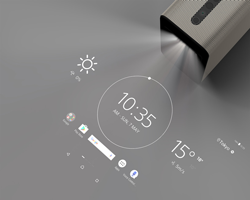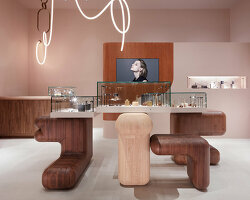since 1957, the japan GOOD DESIGN award has aimed to promote the enrichment of lives, industries and society through design, most significantly with its ‘g mark’ emblem becoming a symbol for its comprehensive design values. the laureates for the 2017 edition have once again exemplified the great diversity of the competition, where the winning projects range from sony’s highly technical ‘xperia touch’ to yamaha’s radically re-designed music instrument, and onwards to the grand and traditionally japanese interiors of the ‘shiki shima’ train. however, the principles of the GOOD DESIGN award has created benefits across all fields of design. it has not only inspired one or two truly innovative and first-of-a-kind products, but countless of leading projects that have each generated positive changes in one form or another.
to showcase how the japan GOOD DESIGN AWARD 2017 has taken these values further, and also seen further effect of its ambition, designboom spoke to kazufumi nagai, chairman of the GOOD DESIGN award, fumie shibata, vice chariman, and koichi suzuno of torafu architects, jury member and designer of this year’s exhibition space.

chairman kazufumi nagai (right) and vice chairman fumie shibata (left)
image © designboom
(fullheader image: daici ano)
designboom (DB): what are your overall impressions of this year’s GOOD DESIGN award?
chairman kazufumi nagai (KN): one of the best results is that the number of applications has increased by 10% from 2016. arguably, I think that this means that the concepts and fields of design have penetrated into the lives of people land are now showing the results of this added interest. the GOOD DESIGN award is still spreading its fields. compared to other competitions around the world, we focus our judging more on the systems and background of the design, rather than its aesthetics. I think that this unique method of evaluating designs has helped to increase the number of applications.
furthermore, until recently, the majority of applications were from ‘pure’ or typical designers, such as product designers, graphic designers, architects, etc. however, recently, the number of applications from local people, or those who engage in town planning or administration, has increased and those who have a direct role in design is also rising in numbers.
vice chairman fumie shibata (FS): when we started this project three years ago, we did not feel that the industry of design was very good. now, our position has completely changed and we have started to see the signs of new success in design. last year, we some but only minimal development. following that, this year, we have witnessed the most fruitful of projects in all of our history. I am trained product designer, so from that view point, the industry of product design was also not considered good. however, this year, we have found some particularly nice japanese designs. for the results, the yamaha’s venova won the japan GOOD DESIGN grand award, whilst the ‘shiki-shima train’ and sony’s ‘xperia’ touch won the japan GOOD DESIGN gold award. they are both innovative and well-designed products that have revived japanese product design and manufacturing.

yamaha’s ‘venova’ wins japan GOOD DESIGN grand award
image © yamaha
see more of the project on designboom here

train suite shiki-shima
image © east japan railway company
see more of the project on designboom here
DB: from this year’s competition, has there been any brand new designs?
KN: particularly in the digital industry, with the sony’s ‘xperia’ touch, a new service and interaction was born with an innovative technology was introduced, including a new sensing technology. the ‘SEND’ has been realized with an advanced technology to analyze large sums of data. the project highlights how new technology, and the speed of its development, is able to realize designs that were not possible very recently.
FS: I have an impression that we have received many brand new objects that have never existed before.

sony xperia touch
image © sony
see more of the project on designboom here

SEND is a brand-new distribution platform for increasing farmers’ income and supporting sustainable production
image © planet table inc

japan GOOD DESIGN award 2017 gold award projects
DB: what was the process of designing the japan GOOD DESIGN award exhibition space?
koichi suzuno (torafu architects)(KS): I have been working as part of the jury for the japan GOOD DESIGN award for three years and from these past experiences, realized that the exhibition space’s design needed to be huge and have many floors and posts to see the works, as sometimes I have missed a few pieces of work accidentally. for this reason I have created a concept designed to ‘connect’ five or six places to exhibit. we, the 82 jury members, judge the projects seriously and thoroughly by spending all three days in tokyo’s big sight district. I wish this elaboration could be communicated with visitors as I wanted to connect the exhibition space (tokyo midtown) and the tokyo big sight to judge in.

image: daici ano

image © designboom
KS (continued): in many ways, I have been thinking about ’connecting’. the first thing to consider is, when you enter inside the exhibition space of the best 100 display, you can see a photograph of the second judge’s space at the tokyo big sight on the wall. it is a really big image so that visitors can feel as if they are in the judging place themselves.
secondly, the furniture for the exhibition space is composed of the most important product, the ‘AA’ stool from ishinomaki koubou, which we found in a DIY factory after the 2011 disasters. we have developed a system to produce and rent the furniture for this exhibition. all the products will then be returned and re-used in the future.
for the graphic design, I collaborated with japanese graphic designer norio nakamura, who designed a character ‘G-markun’ (‘kun’ is a japanese pet name). as you know, the original G-mark logo is designed by yusaku kamekura. I wanted to use this logo many times, but it can be interpreted as quite authoritarian. instead of removing its authoritarian image by making the logo smaller, as then it will be difficult to understand, we wanted another piece of graphic design to highlight that this exhibition is by G-mark. therefore, I thought that a character could guide visitors around the exhibition space and make a nice atmosphere. at the atrium, you can find the nine meter G-markun made from balloons, and in front of it, there is a store where guests can purchase awarded items.

koichi suzuno (torafu architects)
image © designboom

image © designboom

AA stool’s legs
image © designboom

AA stool’s legs detail
image © designboom

image: daici ano

image: daici ano
the ever increasing number of applicants is no wonder when seeing past winners of the japan GOOD DESIGN award. since 1957, the majority of the recipient projects have become iconic in their own rights, but are all grouped as previous G-mark winners. looking back through the archive, each one, no matter whether it is a first-of-a-kind or not, has been instrumental in catalyzing a positive change in life. these are as diverse as the technology advanced sony am radio ‘tr-610’ from 1958, fujifilm disposable camera from 1986, and sony playstation from 1994 to the more traditional products of the hakusan porcelain soy sauce dispenser by masahiro mori from 1961 and butterfly stool by sori yanagi from 1966. below, designboom has listed just a few of the previous awarded products that have since become timeless classics of design.

am radio ‘tr-610’ by sony awarded in 1958
image © sony

soy sauce dispenser by masahiro mori for hakusan porcelain awarded in 1961
image © hakusan porcelain., ltd

butterfly stool by sori yanagi awarded in 1966
image © tendo mokko

motorcycle ‘zeq/passol’ by yamaha awarded in 1977
image © yamaha

disposable camera by fujifilm awarded in 1986
image © fuji film

soy sauce bottle 150ml by kenji ekuan awarded in 1993
image © kikkoman

aibo by sony awarded in 1999
image © sony

robot suit HAL-5 by elm design awarded in 2006
image © cyberdyne inc, elm design co.,ltd

authagraph by hajime narukawa wins 2016 japan GOOD DESIGN grand award
image © narukawa laboratory, keio university graduate school of media and governance
see more of the project on designboom here













the GOOD DESIGN award was founded in 1957 by the japanese ministry of international trade and industry and is hosted by the japan institute for design promotion. the ‘g mark’ emblem reflects comprehensive design values and principles that aim to enrich lives, industries and society.
g-mark japan GOOD DESIGN award (60)
g-mark japan GOOD DESIGN award 2017 (5)
TORAFU architects (61)
PRODUCT LIBRARY
a diverse digital database that acts as a valuable guide in gaining insight and information about a product directly from the manufacturer, and serves as a rich reference point in developing a project or scheme.


















